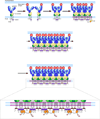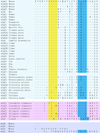Encoding immunological memory in the initiation of B-cell receptor signaling
- PMID: 24100585
- PMCID: PMC4157304
- DOI: 10.1101/sqb.2013.78.020206
Encoding immunological memory in the initiation of B-cell receptor signaling
Abstract
In one of the earliest events in the initiation of antigen-driven antibody responses, naïve, IgM-, and IgD-expressing B cells enter germinal centers where they irreversibly isotype switch to the expression of predominately IgG B-cell receptors (BCRs). The IgG-expressing B cells then undergo rounds of antigen-driven selection, ultimately exiting germinal centers as IgG-expressing memory B cells or plasma blast. This early switch from IgM to IgG begs the question: Of what advantage to the memory response is the B cell's expression of an IgG BCR? Despite convincing evidence that the expression of IgG BCRs is essential for antibody memory responses in vivo, the molecular basis of this requirement is only incompletely understood. Here we describe intrinsic features of IgG BCRs that endow memory B cells with the ability to rapidly and efficiently initiate signaling. Remarkably, efficient signaling is mediated through the cytoplasmic tail of the membrane IgG that binds to synapse associated protein 97, a member of a large family of proteins that are best studied for their role in regulating receptor signaling in neuronal synapses. These findings underscore an interesting parallel in the mechanisms at play in encoding immunological memory and memory in the nervous system.
Copyright © 2013 Cold Spring Harbor Laboratory Press; all rights reserved.
Figures


Similar articles
-
The scaffolding protein synapse-associated protein 97 is required for enhanced signaling through isotype-switched IgG memory B cell receptors.Sci Signal. 2012 Jul 31;5(235):ra54. doi: 10.1126/scisignal.2002820. Sci Signal. 2012. PMID: 22855505 Free PMC article.
-
Enhancement and suppression of signaling by the conserved tail of IgG memory-type B cell antigen receptors.J Exp Med. 2007 Apr 16;204(4):759-69. doi: 10.1084/jem.20061923. Epub 2007 Apr 9. J Exp Med. 2007. PMID: 17420266 Free PMC article.
-
How B cells remember? A sophisticated cytoplasmic tail of mIgG is pivotal for the enhanced transmembrane signaling of IgG-switched memory B cells.Prog Biophys Mol Biol. 2015 Sep;118(3):89-94. doi: 10.1016/j.pbiomolbio.2015.04.010. Epub 2015 May 21. Prog Biophys Mol Biol. 2015. PMID: 26004919 Review.
-
Intrinsic differences in the initiation of B cell receptor signaling favor responses of human IgG(+) memory B cells over IgM(+) naive B cells.J Immunol. 2012 Apr 1;188(7):3332-41. doi: 10.4049/jimmunol.1102322. Epub 2012 Feb 29. J Immunol. 2012. PMID: 22379037 Free PMC article.
-
No receptor stands alone: IgG B-cell receptor intrinsic and extrinsic mechanisms contribute to antibody memory.Cell Res. 2014 Jun;24(6):651-64. doi: 10.1038/cr.2014.65. Epub 2014 May 20. Cell Res. 2014. PMID: 24839903 Free PMC article. Review.
Cited by
-
Metabolic Regulation of the Immune Humoral Response.Immunity. 2017 May 16;46(5):743-755. doi: 10.1016/j.immuni.2017.04.009. Immunity. 2017. PMID: 28514675 Free PMC article. Review.
-
Peripheral immunological characteristics of spontaneous pneumothorax: a Mendelian randomization study.J Thorac Dis. 2024 Sep 30;16(9):5559-5570. doi: 10.21037/jtd-24-798. Epub 2024 Sep 13. J Thorac Dis. 2024. PMID: 39444894 Free PMC article.
References
-
- Batista FD, Iber D, Neuberger MS. B cells acquire antigen from target cells after synapse formation. Nature. 2001;411:489–494. - PubMed
-
- Cyster JG. B cell follicles and antigen encounters of the third kind. Nat Immunol. 2010;11:989–996. - PubMed
-
- Depoil D, Fleire S, Treanor BL, Weber M, Harwood NE, Marchbank KL, Tybulewicz VL, Batista FD. CD19 is essential for B cell activation by promoting B cell receptor-antigen microcluster formation in response to membrane-bound ligand. Nat Immunol. 2008;9:63–72. - PubMed
MeSH terms
Substances
Grants and funding
LinkOut - more resources
Full Text Sources
Other Literature Sources
Research Materials
